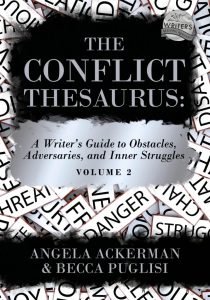
Today’s post is by Angela Ackerman (@WriterThesaurus), co-author of The Conflict Thesaurus, Volume 2: A Writer’s Guide to Obstacles, Adversaries, and Inner Struggles.
Have you ever been a bit hazy on the difference between conflict and tension? If so, you aren’t alone. It’s common to confuse the two because they’re often used together to deliver a one-two dramatic punch.
The difference between them is subtle, but important:
Conflict is a force that stands between your characters and what they want most.
Tension is the feeling of anticipation surrounding what will happen next.
Conflict is concrete—a roadblock, dilemma, danger, adversary, etc. that represents a real problem for the character. Tension is more under the surface, where less is known. There’s a problem bubbling, potential for disruption, or certain factors are coming together which point toward a specific outcome. But will this outcome be realized? Will the right things happen to create chaos? This “will it happen or won’t it” anticipation keeps readers on edge, which is why tension is so good for our story.
We can make good use of the reader’s need to know by building scenes that cater to it. For example, imagine a jerk character in our story who is dating two women, Alice and Shai. Neither is aware of the other, which is just how Logan wants to keep it. But in an epic goof, he asks them both to meet him for dinner at the same restaurant on the same night.
When the women arrive (at the same time, of course), that’s conflict. When they both cross the room, unaware they’re meeting the same man, that’s tension.
Tension draws readers in by causing them to mentally ask questions:
Will the women find out Logan’s dating them both?
Will he worm his way out of it somehow?
What will the women do?
Will there be a big blowout?
Strong tension follows a pattern of pull-and-release—meaning, you let the tension build until it reaches its peak then resolve it by answering some of those unspoken questions.
We’ll imagine that Logan sees the two women. Doom is approaching on stilettos, and he has no idea what to do. One thing is certain, though: when they reach his table, it’s over.
Now, if we wanted to continue building tension, we could add an event that delays the inevitable. Maybe Shai drops a scarf halfway to the table and Alice notices. She retrieves it and stops Shai to return it.
Tension builds as they trade a few words. Logan watches this horror unfold: Will one of them mention me? Point? Will they turn on me with death in their eyes?
Readers know Logan is dead meat…unless we cut him some slack by flipping his tension from negative anticipation to positive.
We can do that by introducing another event.
Perhaps after accepting the scarf, Shai glances toward the restroom. Logan watches, his mind ablaze, hoping against hope she’ll head there, not the table, so that when Alice reaches him, he can quickly make an excuse that he’s sick and they need to leave. Then he can text Shai while she’s in the restroom with a similar explanation for his absence.
Readers watch this new development and think, Will she go to the restroom? Is this his way out?
Anticipation builds and again we achieve pull-and-release by answering internal questions.
As the authors, we decide Shai doesn’t hit the restroom, and so both women arrive at his table at the same time. Sorry, Logan, you jerk. No easy out for you.
After a moment of confusion, the blowout that Logan and the reader have anticipated happens. Shai and Alice start shouting at him, and every diner stops eating to watch the show. Embarrassed, he pleads for them to calm down, which only fires them up. Finally, Alice snatches a bowl of soup from a passing waiter’s tray and dumps it over Logan’s head. Tension is again released.
Shai asks Alice if she wants to get a drink, and the two leave. Logan, dripping chowder, signals for the bill, relieved that the restaurant is far from home and no one he knows will have witnessed this.
This last line provides us with a classic opportunity to use another tool in our tension belt: foreshadowing. What might that look like?
Perhaps as Logan picks clams off his face, he catches someone filming him with their phone, and he realizes they’ve likely caught the whole, messy scene on video. His guts tightens because he knows nothing good can come of this.
And the reader does too. More internal questions arise:
Will that video show up online?
Will someone see it and recognize him?
As you can see, tension affects both readers and characters. A new situation, threat, or obstacle appears, and provided something’s at stake, an unasked question hangs in the air: What comes next?
Tension can result from all kinds of conflict scenarios, such as when the character…
- Is wrestling with competing goals, needs, or desires.
- Must make a decision without all the facts.
- Is unable to resolve a problem.
- Is waiting on an outcome.
- Has no good options.
- Doesn’t know how bad the fallout will be.
- Doesn’t know who will pay the price for their actions.
- Doesn’t know who to trust.
- Can’t predict how someone will react.
Notice the repeated theme here: something is unknown. Exploit that ignorance or uncertainty and let the tension build.
Note from Jane: If you enjoyed this post, be sure to check out The Conflict Thesaurus, Volume 2: A Writer’s Guide to Obstacles, Adversaries, and Inner Struggles by Angela Ackerman & Becca Puglisi.
Angela Ackerman is a writing coach, international speaker, and co-author of The Emotion Thesaurus: A Writer’s Guide to Character Expression and its many sequels. Available in ten languages, her guides are sourced by universities, recommended by agents and editors, and are used by novelists, screenwriters, and psychologists around the world. Angela is also the co-founder of the popular site Writers Helping Writers, as well as One Stop for Writers, a portal to game-changing tools and resources that enable writers to craft powerful fiction.


Love this example! Thanks for your insight. And I must admit I did not anticipate the filming of the incident. That was perfect.
HI Maggie! Thank you. I think we should always push ourselves to think about further complications (when they make sense for the story we’re writing). Sometimes there’s an opportunity to take what seems like an isolated incident and make it a trigger for something else. As long as we don’t overuse this technique, it’s a great way to surprise readers because they were being led to think the situation was resolved, and then bam, they now need to read on because it is not!
Thanks, Maggie! Hope it gives you some ideas down the road 🙂
Superb! I own the book as well as her others and recently subscribed to One Stop for Writer. Thank you as always.
Darlene, so glad this was helpful and love that you’re at One Stop for Writers, too!
Darlene, thank you! And I hope you’re finding One Stop for Writers to be a big help, too!
A great read, Angela!
This is a great way to engage with your readers. When you engage with their mind in such a way that they have to question, then you hook them for longer.
Thanks for sharing this!
Regards.
This is exactly it. One thing I know I admire when I read is an author that can lead me down a trail by keeping me guessing. I love it when ‘what comes next’ isn’t what I expect. Glad you enjoy this post!
Thanks so much, Freddy! I agree, activating their “need to know” is huge!
Love this, Angela–a succinct and clear explanation–and actionable, my favorite thing. 🙂
Thanks, Tiffany! Glad you like this one. 🙂
Excellent post, Angela. You built tension in me with your example! ????
I’m so glad you liked this post, and I’m glad the example did its job!
Good points, explained well and worth a read. Thank you Angela.
So glad you liked this one, Raymond. Have a great week!
I think I get it.
Novice here. One of my first craft lessons warned me against too many question marks.
But you’re saying plop those questions right into the text, question mark and all?